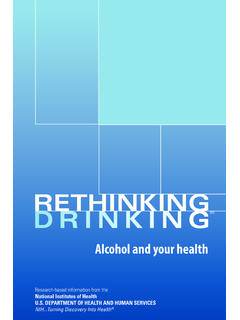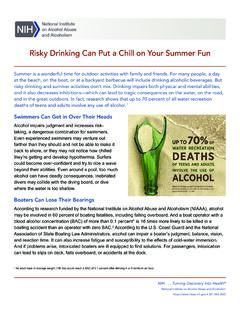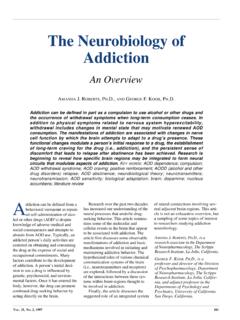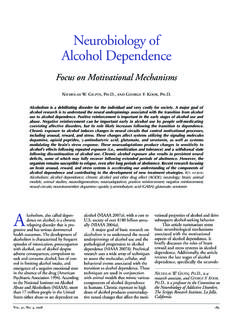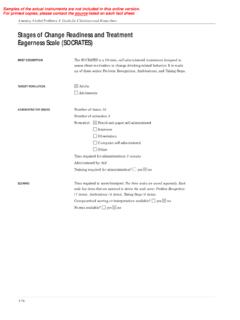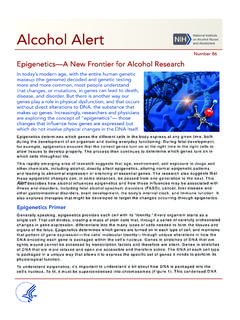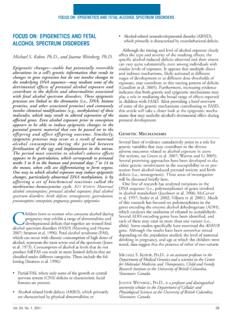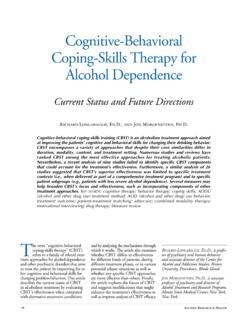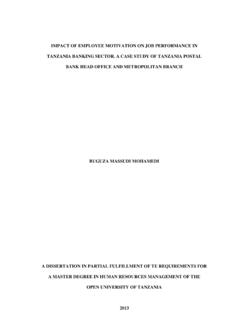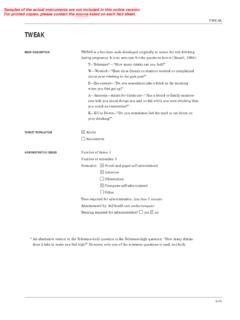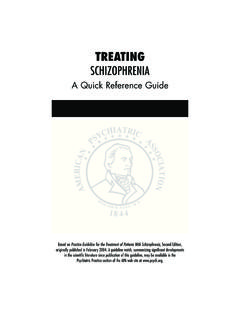Transcription of The Community-Reinforcement Approach
1 The community - reinforcement Approach William R. Miller, , and Robert J. Meyers, , with Susanne Hiller-Sturmh fel, The Community-Reinforcement Approach (CRA) is an alcoholism treatment Approach that aims to achieve abstinence by eliminating positive reinforcement for drinking and enhancing positive reinforcement for sobriety. CRA integrates several treatment components, including building the client's motivation to quit drinking, helping the client initiate sobriety, analyzing the client's drinking pattern, increasing positive reinforcement , learning new coping behaviors, and involving significant others in the recovery process. These components can be adjusted to the individual client's needs to achieve optimal treatment outcome.
2 In addition, treatment outcome can be influenced by factors such as therapist style and initial treatment intensity. Several studies have provided evidence for CRA's effectiveness in achieving abstinence. Furthermore, CRA has been successfully integrated with a variety of other treatment approaches, such as family therapy and motivational interviewing, and has been tested in the treatment of other drug abuse. KEY WORDS: AODU (alcohol and other drug use). treatment method; reinforcement ; AOD (alcohol and other drug) abstinence; motivation; AOD. use pattern; AODD (alcohol and other drug dependence) recovery; treatment outcome;. cessation of AODU; professional client relations; family therapy; motivational interviewing.
3 Spouse or significant other; literature review I. n nearly every review of alcohol The user experiences effects that moti- treatment outcome research, the vate him or her to continue drinking, WILLIAM R. MILLER, , is director Community-Reinforcement Approach which can lead to alcohol dependence. of research and ROBERT J. MEYERS, , (CRA) is listed among approaches with What then would make a dependent is a senior research scientist at the Center the strongest scientific evidence of efficacy. drinker want to give up drinking? One on Alcoholism, Substance Abuse, and Yet many clinicians who treat alcohol common Approach is to turn up the Addiction, University of New Mexico, problems have never heard of it, despite pain that is, to confront the person Albuquerque, New Mexico.
4 The fact that the first clinical trial of with unpleasant and costly consequences CRA was published over a quarter of a of drinking. This Approach attempts to SUSANNE HILLER-STURMH FEL, , century ago an example of the contin- render drinking less attractive, and can is a science editor of Alcohol Research uing gap between research and practice. include aversion therapies, pharma- & Health. The underlying philosophy of CRA cotherapy with the medication disulfi- is disarmingly simple: In order to over- ram, confrontational counseling, and The authors gratefully acknowledge the come alcohol problems, it is important infliction of negative consequences ( , support of the National Institute on to rearrange the person's life so that punishment).
5 Such negative approaches, Alcohol Abuse and Alcoholism and the abstinence is more rewarding than however, frequently have been found to National Institute on Drug Abuse for drinking. The use of alcohol as well as be ineffective in decreasing drinking and several of the clinical studies summarized other drugs can be highly reinforcing: alcohol problems (Miller et al. 1998). in this report. 116 Alcohol Research & Health Community-Reinforcement Approach to come Even seasoned clinicians are often amazed Building Motivation Analyzing Drinking Patterns at how much adversity an alcoholic will The initial step in CRA generally is an CRA involves a thorough functional endure in order to continue drinking.
6 Exploration of the client's motivations analysis of the client's drinking patterns. In fact, it has been said that if punishment worked, there would be no alcoholics. for change. Particularly in early versions This analysis helps identify situations CRA takes a different Approach to of CRA, this process involved the iden- in which drinking is most likely to overcoming alcohol problems, one that tification of positive reinforcers ( , occur ( , high-risk situations) as well is based on providing incentives to stop praise and shared pleasant events) that as positive consequences of alcohol drinking rather than punishment for could serve as effective incentives for consumption that may have reinforced continued drinking.
7 To that end, client, the client to change his or her behavior. drinking in the past. This step, which therapist, and significant others work The CRA therapist also reviews with is often underemphasized in cognitive- together to change the drinker's lifestyle the client the current and future nega- behavioral therapy, is useful in individ- ( , his or her social support system tive consequences of the client's drink- ualizing treatment and in determining and activities) so that abstinence becomes ing patterns. For example, the therapist specific treatment components, or more rewarding than drinking. Since may offer an inconvenience review modules, that are most likely to be suc- its introduction by Hunt and Azrin in checklist a list of frequent negative cessful for a particular client.
8 1973, CRA treatment has evolved con- consequences of drinking, such as med- siderably, and the clientele has expanded ical problems, marital problems, or dif- Increasing Positive reinforcement to include spouses of alcoholics and ficulties at work. The client then checks users of drugs other than alcohol. This all those negative consequences that Once the analysis of the client's drink- article summarizes the components of apply to his or her current situation or ing patterns is completed, both the CRA as well as factors influencing its are likely to occur in the future. This client and therapist select appropriate effectiveness. In addition, the article assessment can be conducted in an modules from a menu of treatment briefly reviews clinical studies demon- empathic motivational interviewing procedures to address the client's indi- strating CRA's efficacy in treating clients style rather than a confrontational style vidual needs.
9 Many of these treatment with alcohol and other drug (AOD) (Miller and Rollnick 1991), thereby modules focus on increasing the client's problems. encouraging the client, rather than the sources of positive reinforcement that therapist, to voice the advantages of are unrelated to drinking. For example, change and the disadvantages of his or as people become increasingly depen- What Is CRA? her current drinking. dent on alcohol, their range of non- drinking activities ( , hobbies, sports, To provide an alcoholic with the incen- and social involvement) narrows substan- Initiating Sobriety tive to quit drinking, CRA has the fol- tially, resulting in increasing isolation.
10 Lowing two major goals: Once the client has identified factors Consequently, an important component that provide the motivation to change of recovery for the drinker is to reverse Elimination of positive reinforce- his or her drinking behavior, the thera- this isolation process by becoming ment for drinking pist moves on to setting goals for involved with other nondrinking people achieving abstinence. Because many and by increasing the range of enjoyable Enhancement of positive reinforce- clients are reluctant to commit them- activities that do not involve drinking. ment for sobriety. selves to immediate total and perma- Several treatment modules can help nent abstinence, a procedure called in this process.
